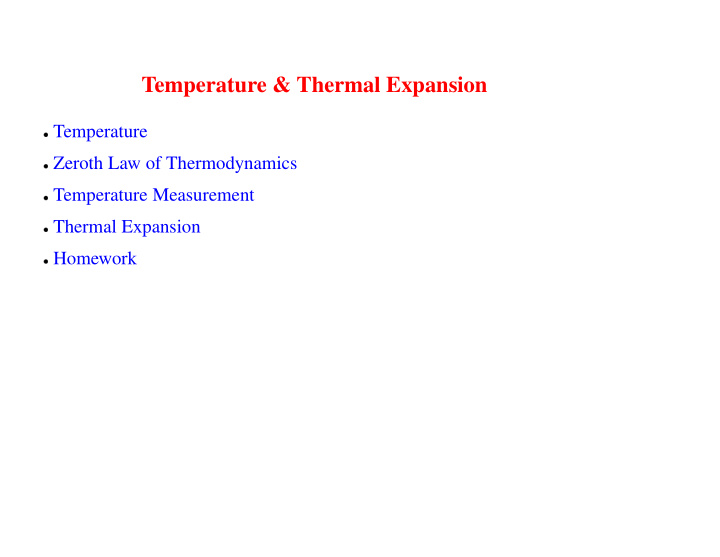



� � � � � Temperature & Thermal Expansion Temperature Zeroth Law of Thermodynamics Temperature Measurement Thermal Expansion Homework
� � Temperature & Thermal Equilibrium Temperature – Fundamental physical quantity – Measure of average kinetic energy of molecular motion Thermal equilibrium – Two objects in thermal contact cease to have an exchange of energy
The Zeroth Law of Thermodynamics If objects A and B are separately in thermal equilibrium with a third object C (the thermometer), the A and B are in thermal equilibrium with each other.
� � Temperature Measurement In principle, any system whose physical properties change with tempera- ture can be used as a thermometer Some physical properties commonly used are – The volume of a liquid – The length of a solid – The electrical resistance of a conductor – The pressure of a gas held at constant volume – The volume of a gas held at constant pressure
� � � The Glass-Bulb Thermometer Common thermometer in everyday use Physical property that changes is the volume of a liquid - usually mercury or alcohol Since the cross-sectional area of the capillary tube is constant, the change in volume varies linearly with its length along the tube
� � � Calibrating the Thermometer The thermometer can be calibrated by putting it in thermal equilibrium with environments at known temperatures and marking the end of the liquid column Commonly used environments are – Ice-water mixture in equilibrium at the freezing point of water – Water-steam mixture in equilibrium at the boiling point of water Once the ends of the liquid column have been marked for a couple differ- ent environments, a scale must be defined
� � ✁ ✁ The Celsius Scale A common temperature scale is the Celsius scale On this scale the freezing point is at zero degrees (0 C) and the boiling point is at 100 degrees (100 C)
� � � � ✂✄ ☎ ✆ The Constant-Volume Gas Thermometer The standard thermometer, against which all other thermometers are calibrated Measures the pressure of the gas contained in the flask immersed in the bath The volume of gas in the flask is kept constant be raising or lowering reservoir B such that the mercury level in column A remains constant Pressure is determined from the height h of the mercury in the reservoir (P = P + gh)
� � ✝ � ✝ Absolute Zero Experiments show that the results obtained with the constant-volume gas thermometer are nearly independent of the type of gas used If the measurements are performed with the gas in the flask at different starting pressures at 0 C, different straight-line calibration curves are obtained All of these curves extrapolate to zero pressure at the unique temperature of -273.15 C
� ✝ � � ✞ The Kelvin Scale Absolute zero is used as the basis for the Kelvin temperature scale in which -273.15 C is set as the zero point (0 K) The size of a degree on the Kelvin scale is the same as the size of a degree on the Celsius scale The conversion between the Kelvin and Celsius scales is given by T = T - 273.15
✞ � � ✡ ✠ � ✟ ☛ ✟ ✝ ✝ ✠ ✝ ✡ � ☛ ✞ The Fahrenheit Scale The most common temperature scale The ice point is at 32 F and the steam point is at 212 F The relationship between the Fahrenheit scale and the Celsius scale is given by T = T + 32 F The relationship between changes in temperature on the two scales is given by T = T
☞ ☞ ✒ ✎ � ✓ � ✒ ✏ ☞ ✌✑ ✍ ✌ ✏ ✎ ✌✍ ✌✑ ✓ ✌ ✓ ☞ ✏ ✌ Thermal Expansion If the temperature of a metal rod of length L is raised by an amount T, its length is found to increase by an amount where is a constant called the coefficient of linear expansion. If the temperature of a solid or liquid whose volume is V is increased by an amount T, the increase in volume is found to be where is the coefficient of volume expansion. (Note that = 3 .)
Expansion Coefficients for Some Materials
✕ ✔ ✖ ✁ Example On a hot day in Las Vegas, an oil trucker loaded 37,000 L of diesel fuel. He encountered cold weather on the way to Payson, Utah, where the temperature was 23.0 K lower than in Las Vegas, and where he delivered his entire load. How many liters did he deliver? The coefficient of volume expansion for diesel fuel is 9.50 10 / C.
� ✁ � ✁ � The Unusual Behavior of Water At temperatures above 4 C, water behaves like most liquids and contracts as it is cooled But, at temperatures below 4 C it expands as it is cooled This is why bodies of water freeze at the surface and why freezing water can break sealed containers
� � � Homework Set 1 - Due Wed. Jan 7 Read Sections 16.1 - 16.3 Answer Questions 16.1, 16.4 & 16.5 Do Problems 16.1, 16.3, 16.8, 16.13 & 16.14
Recommend
More recommend